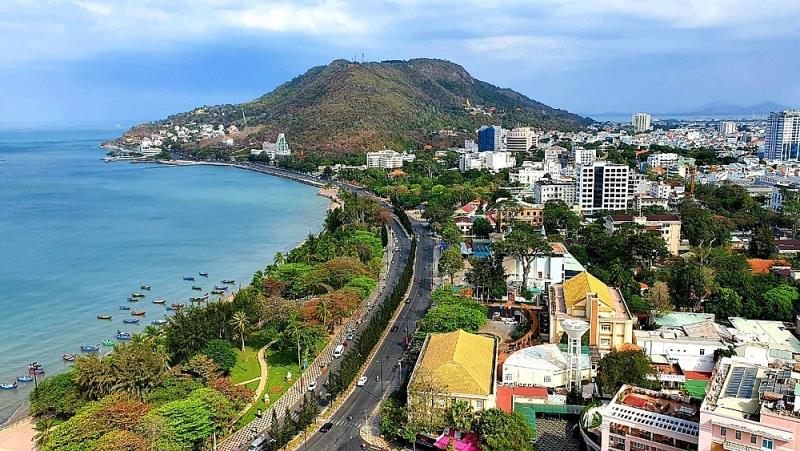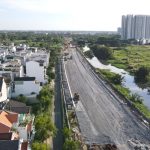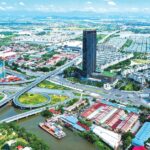The Southeast region of Vietnam, also known as the Eastern region, comprises Ho Chi Minh City and the five provinces of Ba Ria-Vung Tau, Binh Duong, Binh Phuoc, Dong Nai, and Tay Ninh. Ho Chi Minh City is a centrally-controlled municipality with a special status.
According to the approved master plan for the 2021-2030 period, with a vision towards 2050, two provinces, Ba Ria-Vung Tau and Binh Duong, are oriented to become or meet the criteria to be centrally-controlled municipalities. The remaining localities will continue to develop their economic potential but are not oriented towards becoming central cities.
Ba Ria-Vung Tau to Meet Criteria for Central City Status by 2030
Specifically, according to the master plan for Ba Ria-Vung Tau province for the period of 2021-2030, with a vision towards 2050, the province aims to “basically meet the criteria of a centrally-controlled city by 2030.”
The plan sets out a general objective to build Ba Ria-Vung Tau into a comprehensively developed region, becoming one of the important driving forces of the Southeast region, a national maritime economic center, and ranking among the top five localities in the country in terms of maritime economic development. By 2030, it aims to essentially meet the criteria of a centrally-controlled city, with a multi-center urban structure and a multi-modal transport infrastructure.

Ba Ria-Vung Tau aims to maintain its position in the top 10 localities in terms of GRDP and total state budget revenue.
At the same time, it aims to firmly maintain its position in the top 10 localities in terms of GRDP and total state budget revenue; achieve harmonious economic development while ensuring social progress, improving the quality of life for its citizens, and protecting the environment; efficiently manage and utilize resources; adapt to climate change and sea-level rise; and ensure national defense, security, and the inviolability of sovereignty and territorial integrity.
By 2050, Ba Ria-Vung Tau is envisioned to be a national maritime economic center, a maritime services hub in Southeast Asia, a high-quality international tourism center, and one of the major industrial centers of the Southeast region.
The province will have a complete and modern infrastructure system, a safe, healthy, and high-quality living environment, and a society that is in harmony with nature. Its economy will be efficiently developed towards a circular, green, and low-carbon model, and it will strive to achieve net-zero emissions.
Binh Duong to Become a Central City by 2030
“By 2030, Binh Duong will become a centrally-controlled city,” affirms the master plan for Binh Duong province for the 2021-2030 period, with a vision towards 2050.
By 2030, Binh Duong aims to be one of the most dynamic and comprehensive development centers in Southeast Asia, leading in science, technology, and innovation, and a modern industrial and service center. Its socio-economic infrastructure system and urban system will be synchronously developed, modern, intelligent, and sustainable, following a green growth model that adapts to climate change and protects the ecological environment.

By 2030, Binh Duong aims to be one of the most dynamic and comprehensive development centers in Southeast Asia.
It will also strive to improve the quality of life for its citizens, building a prosperous, civilized, and modern society, while ensuring national defense, security, and social order and safety.
The vision for 2050 is to develop Binh Duong into a modern urban, industrial, and service center with regional and international stature, serving as one of the main drivers of national economic development. Its primary growth drivers will be industry, services, and innovation, with a solid economic foundation and high competitiveness. The province aims for its citizens to enjoy a high quality of life, with income levels on par with developed countries.
Economic Overview of Binh Duong and Ba Ria-Vung Tau
Currently, Binh Duong and Ba Ria-Vung Tau are the two top-performing economies in the country.
In 2023, Binh Duong’s gross regional domestic product (GRDP) is estimated to have increased by 5.97% compared to the previous year. Per capita GRDP reached VND 172 million per year. The province achieved a trade surplus of approximately USD 8.8 billion, with export turnover reaching USD 30.9 billion and import turnover estimated at USD 22.1 billion. Total state budget revenue was estimated at VND 73,258 billion.
Binh Duong attracted USD 1.5 billion in foreign direct investment (FDI) in 2023. As of early 2024, Binh Duong ranked second in the country, after Ho Chi Minh City, in attracting FDI with 4,219 valid projects and a total registered capital of over USD 40.31 billion.
In 2023, Ba Ria-Vung Tau’s GRDP was estimated at VND 366,456 billion, and per capita GRDP was VND 308.7 million per year, a decrease of 5.47% compared to 2022. Excluding oil and gas, the province’s GRDP in 2023, in comparable prices to 2010, was estimated at VND 122,939.6 billion, an increase of 5.75% compared to the previous year.
In 2023, Ba Ria-Vung Tau attracted approximately VND 61,600 billion in new investment capital and additional capital for projects, equivalent to USD 2.52 billion, an increase of over 26% compared to 2022 and reaching nearly 149% of the plan. FDI attraction reached over USD 1.4 billion, an increase of 92% compared to 2022.
Proposed Planning for Adding 2 New Cities in Ho Chi Minh City
According to Architect Ngô Viết Nam Sơn, Ho Chi Minh City should consider planning two cities within the city in the south and north.
2023 Remittances Surpass Half of Ho Chi Minh City’s Budget Revenue
As part of the Homeland Spring 2024 program in Ho Chi Minh City, this morning (2/2), the overseas Vietnamese delegation had a tour of the City Hall and met with city leaders.


















